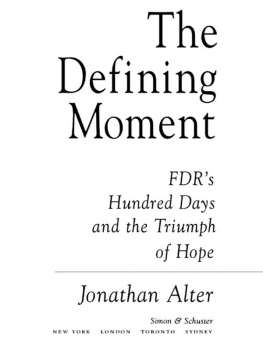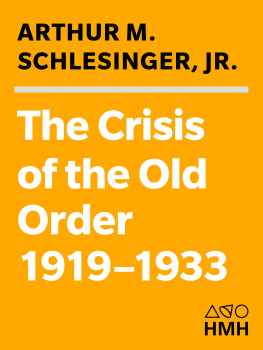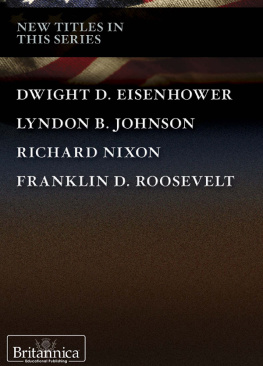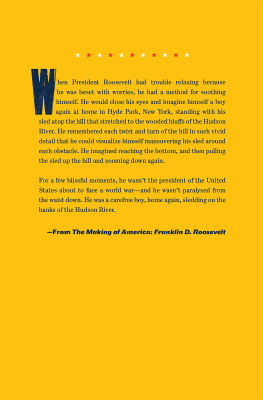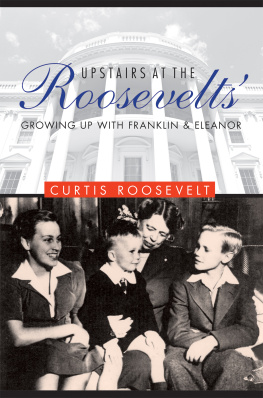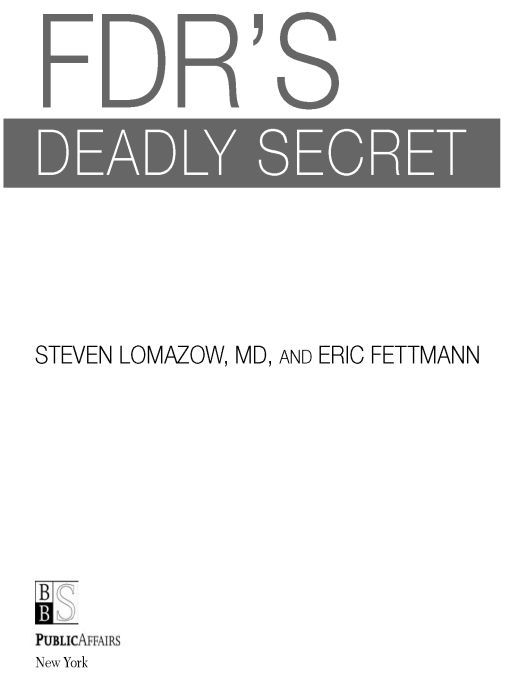Table of Contents
For Isabelle Faye Lomazow and Grace Maya Lomazow,
whose lives are just beginning,
and to the memory of
Sadie Feldman Fettmann (1920-1971)
and Morton Fettmann (1921-1978),
who grew up in the FDR years
PREFACE
This story begins in 1979, with the publication of Dr. Harry Goldsmiths landmark paper, Unanswered Mysteries in the Death of Franklin D. Roosevelt, by the medical journal Surgery, Gynecology & Obstetrics, the first peer-reviewed examination that challenged the traditional account of FDRs final illness. This paper by a well-respected surgeon, which garnered national attention, raised the possibility that a pigmented lesion over the thirty-second presidents left eyequite visible, but rarely commented on during his lifetimemay have been malignant.
If true, this would suggest the need for a whole new evaluation of Roosevelts final years and the precise nature of the ill health that progressively overtook him. And it raises questions, long debated by historians, as to whether FDR was fully capable of functioning as chief executive and commander in chief during the global conflict of World War II.
In reaction to Goldsmiths article, Roosevelts lone surviving primary physician, Howard Bruenn, emphatically denied that FDR ever had cancer, effectively quashing further speculation and investigation. But the 1991 death of Margaret Daisy Suckley, Roosevelts cousin and frequent companion, led to a surprising discovery: Daisy had kept a secret diary that documented her relationship with FDR, along with many of his previously unknown letters to her. And, to the surprise of Roosevelt biographers, who had dismissed her as a historical footnote, it turns out that FDR had confided things to Daisy he didnt dare divulge to anyone else (save, perhaps, his onetime mistress, Lucy Mercer Rutherfurd), knowing she would protect his secrets.
Like Goldsmiths paper, the startling revelations in Daisys diary, published in 1995, often directly contradicted many of the claims made years earlier by FDRs physicians, including what historians long had accepted as the definitive account of Franklin Roosevelts medical history.
Working with these disclosures, and expanding on them with intensive research, we have produced what essentially is a medical biography of Franklin D. Roosevelt. It presents a strong circumstantial case, backed by surviving medical records and analysis, that Roosevelt did indeed have cancermelanoma, to be exact, originating in the pigmented lesion above his eyethat eventually spread to his brain and his abdomen. In other words, the cerebral hemorrhage that struck him down less than a month before V-E Day was not a bolt out of the blue, as his doctors contended, but the inevitable result of a deadly illness, compounded by catastrophic heart problems.
We did not intend this to be a political book, although it is impossible to avoid politics entirely when considering the effect that cancer had on Roosevelts performance as president. Others can read into this information what they will: Some will see confirmation that FDR was indeed the sick man of Yalta, incapable of negotiating skillfully with the determined Soviet dictator, Joseph Stalin. Others will see a determined champion, tirelessly guiding America through the global conflagration while contending with the ravages of the diseases that threatened his own life.
In fact, even as soldiers were fighting the enemy on the battlefields of Europe, Africa, and Asia, a parallel struggle was under way in the White House to preserve the president himself against the considerable medical challengespolio, heart disease, and cancerthat surrounded him. Roosevelt himself was at the center of this battlenot as a disengaged and uninterested spectator, as historians have long believed, but as a chief executive who ultimately determined the course of his own medical struggle, just as he did in the fight against the Axis powers.
With the help of his doctors, Roosevelt was determined not only to stay alive for the time needed to accomplish his goals, but also to convince the nationand the world at largethat he was always functioning at full capacity. Yet he knew that his was a desperate race against time. In this respect, Franklin Roosevelt took one of the greatest gambles in world historyand won.
CHAPTER 1
An Orator Stumbles
Over the course of his unprecedented twelve years as president of the United States, Franklin Delano Roosevelt hadwhether standing before Congress, addressing a huge political rally, or simply sitting before a microphone while delivering one of his intimate Fireside Chatsenthralled his listeners with self-assured oratory that was simple, yet stirring. But on March 1, 1945, as FDR prepared to tell Congress and a national radio audience about his recent summit at the Crimean city of Yalta with British Prime Minister Winston Churchill and Soviet leader Joseph Stalin, at which they had planned nothing less than the political shape of the postwar world, something about his delivery was very differentand radically wrong.
For one thing, the president was sitting down, something hed never before done while delivering a major address before Congress. And hed been wheeled into the chamber, where previously the chief executive had walked, heavy steel braces tightly supporting his withered legs, while tightly grasping an aides arm. Indeed, in his opening remarks, FDR surprisingly would refer publicly, for the first and only time as president, to the paralysis that had crippled him more than two decades earlier. I hope that you will pardon me for the unusual posture of sitting down during the presentation of what I want to say, Roosevelt told his astonished listeners. But I know that you will realize that it makes it a lot easier for me in not having to carry around ten pounds of steel around the bottom of my legs. This in itself was startling: After all, Roosevelt had waged a determinedand successfulquarter-century-long campaign to keep the American people from fully understanding that he was physically unable to stand without his braces, or to walk unaided.
In his first appearance before Congress in twenty-six months, the president was a weary and exhausted man, both physically and emotionally drained. Just the day before, in a downpour of rain and sleet, he had attended the burial of Gen. Edwin Pa Watson, his trusted military aide and one of his closest friends and advisers. Watsons unexpected death of a stroke aboard the USS Quincy while returning from Yalta had been a crushing blow to the president, who, in an unusual display of emotion, spent the rest of the transatlantic voyage in an obvious state of depression. Physically, Roosevelt was a shell of the powerful and commanding figure hed once presented: Over the past year, hed lost at least forty pounds. He looked gaunt and emaciated, and dark shadows circled his eyes. Even some of FDRs closest aides, like his confidential secretary, William Hassett, were speculating privately that the president was slipping away.
But in front of Congress, Roosevelt had a more immediate and perilous problem. As he began to read from a loose-leaf binder containing thirty-one double-spaced typewritten sheets, the president came to a horrifying realization: He could not fully see all of the words on the page.
For at least six weeks, and possibly longer, FDR had been aware that he had a problem. Progressively, he had lost his ability to readspecifically, he could no longer see the words in the left side of his field of vision; they had either become incomplete or simply were no longer visible at all. To compensate, hed developed a technique, first noticeable a few weeks earlier when he sat for newsreel cameras reading short excerpts from his upcoming State of the Union message, which he did not deliver live to Congress, as was traditional. Roosevelt used his hands as a stylus to mark his place, even crossing them over each other to keep track of his position on the page; it was a procedure hed never before employed while speaking publicly.


